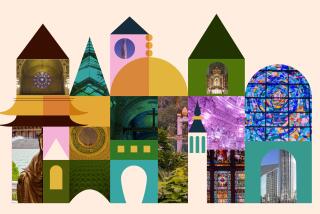Buddhists Wait to Catch Glimpse of Dalai Lama
- Share via
The orderly crowd of Buddhists in the Pasadena Hilton Hotel’s lobby entrance Monday evening had waited hours for the Dalai Lama, but when the spiritual leader finally arrived, few had the chance even to greet him.
Holding incense and katas, traditional blessing scarves, Buddhists from a variety of sects and nationalities said they had hoped to get close enough to the exiled Tibetan spiritual leader to offer him their greetings. But as the Dalai Lama made his way through the crowd, he was escorted by numerous security guards and actor Steven Segal. Within minutes, the Dalai Lama was ushered into an elevator, out of his followers’ sight.
Still, the experience of seeing him, if only for a short glimpse, seemed to elate the Buddhists, many of whom traveled from as far as Hong Kong to attend the three-day religious seminars that the Dalai Lama will conduct at the Pasadena Civic Auditorium today through Thursday.
The Dalai Lama’s visit to Pasadena was protested Monday by the Chinese government, with which the Dalai Lama has had a contentious relationship since the Chinese began tightening their control of Tibet in 1956.
But Pasadena Mayor William Paparian, who met with Chinese Deputy Consul General Yeuke Lu, said the city would not change its plans, which include presenting the Dalai Lama with the key to the city today.
Throughout Pasadena, people of all beliefs have been preparing for his arrival.
In a grand ceremony Sunday, four Tibetan Buddhist monks prepared to create a traditional sand painting at Pasadena’s Pacific Asia Museum.
Consulting ancient blueprints from sacred texts Monday, the monks continued their work, pouring the first sands onto the painting for the Dalai Lama’s five-day visit.
The sand painting is a mandala, a geometric pattern thought to symbolize the universe. And to show the impermanence of the universe, the monks from the Drepung Loseling Monastery in southern India, who will spend the next nine days creating the mandala, will destroy their work when it’s completed, said Yeshi Sherap, one of the monks.
According to museum officials, the sand on the painting will be swept into urns and poured into a stream near the Jet Propulsion Laboratory on Aug. 8.
The mandala’s impermanence is part of its beauty, said Nancy Popp, a student at the Art Center College of Design in Pasadena.
“[The monks] are in the present when they’re making it,” she said. “They’re completely absorbed in what they’re doing. The focus is more on the process than on the end result.”
Carrying a small, unobtrusive video camera, Popp spent the morning in the auditorium where Buddhists and art enthusiasts spoke in hushed tones and admired the monks’ intricate work.
Sherap consulted a yellow book and a parchment scroll as he put final touches on the outline. Fifty Buddhists spent $50 each Sunday to meditate and chant with several monks in a purification and sanctification ritual. On Monday, four monks worked individually and in occasional pairs as spectators strolled in for a $7 tour that will be available until Aug. 7.
Waiting for the last admirers to leave the auditorium so he could take a lunch break, security guard S.O. Griffin paced the incense-filled room and shook his head. The monks’ sketching reminded the non-Buddhist of the first time he had seen a mandala, in 1977 when he was stationed in Korea with the Marines.
“It was beautiful,” he said. “A lot of the G.I.s that weren’t Buddhist didn’t understand destroying it. A lot of people here, when they see this, their pockets are going to be burning. They’re going to be, like, ‘No, don’t destroy it! I’ll pay you not to destroy it.’ ”
Griffin showed the last of the morning visitors out of the building and descended a stone staircase into the museum’s peaceful courtyard garden. Standing amid the Asian statues that encircle a goldfish pond, he described the mandala he saw in Korea as “utopia and ecstasy. Why take it away?”
The museum is extending its hours until 10 p.m. today through Thursday, so that those who will attend the Dalai Lama’s teachings in the auditorium can have an opportunity to view the mandala-making, said Paul Little, director of communications for the museum.
Times religion writer Larry B. Stammer contributed to this story.
More to Read
Sign up for Essential California
The most important California stories and recommendations in your inbox every morning.
You may occasionally receive promotional content from the Los Angeles Times.













